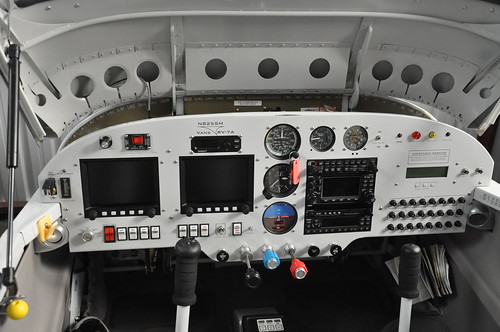Round Dials and Glass Panels
There was a certain elegance in the design of instrument panels with round dial instruments, and I don't mean that in a romantic sense for old times sake. With the "T" instrument arrangement, the airspeed needle at approach speed was in the right side of the case, allowing a quick and accurate instrument scan. The altimeter was not as easy to read, as there were times when the needle went up to minimums, and other times when it went down to minimums (difference between the right and left side of the instrument). For the airspeed indicator, altimeter, and g-meter, they are (my opinion) best viewed as a round dial because one can see both the full range, and detect movement from peripheral vision. Those are the three instruments I retained in my RV-8, and I am using the Dynon D-10A for attitude and heading.
Things that don't move as much, such as engine instruments, are ideal for conversion to glass, with the added benefit that you can program the limits. The example I like to think about are the older airplanes where the engine instruments are in a tiny panel either low in the pilot's field of view, or on the right side of the panel altogether. Hard to see the oil pressure needle flicker and fall to zero in those locations. But with glass, it is right there in front of you, plus a warning.
If your flying is mainly for cross country cruise and instrument proficiency, a well selected glass panel will work great. Corporate aircraft and now even LSAs are getting this technology. But if you want to do aerobatics and fly formation, where quick and accurate glances are necessary, the round dials are still very useful. Remember too that digital readouts require mental processing time, where an analog reading is rather instantaneous, because we are so good at pattern recognition. It will be interesting to see if the generation raised with video games blows right past us old pattern recognizers because they are so good with digits!
When GPS came out, my impression was that people would give up on knowing exactly where on the map they were, and safety would suffer. But the reverse is true: GPS is a huge benefit to safety, and with moving maps we know where we are better than ever before! My only requirement for GPS is that it be panel mounted to avoid mounts and wires, which is another huge endorsement for glass.
So it depends on what you want to do with your RV, and how well you set things up for electrical redundancy. Because of much higher reliability and functionality, glass is here to stay. But for readabilty, round dials have their place. How many of you still have analog watches?





